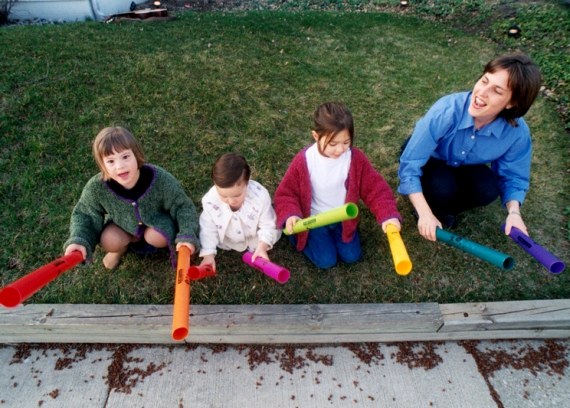“Play Hard” is one of the most important things learned as a child – and a skill grown-ups oftentimes need to rekindle!“
By Janet Ringle-Bartels & Julie Windham
Play.
Although on the surface it seems to be a simple word, it has such a strong impact on a child’s development. But how can play be important? After all, it’s just for fun! But that is the whole idea of development.
The child is learning and developing a variety of skills while being involved in activities that motivate them. Yes, that is play. Remember your childhood memories of playing for hours with your imagination? Remember when you built stilts that allowed you to tower over your friends, those cardboard boxes that magically turned into your secret “hideouts,” the times that you dressed up and became the greatest super hero or when you sang forever with that instrument you made? Children learn through exploration and discovery. Play is the learning “stuff” of childhood because that is their “tool for learning” – a tool which hopefully is transported into adulthood. Adults who played well as a child no doubt know how to play (or relax and have fun) throughout their lives, and are no doubt practicing good team- and social-bonding skills.
Play has so many aspects. It is pleasurable, spontaneous, requires involvement of others, but also supports the child’s individual growth and sense of self as they discover and create in ways that are meaningful to them. Play influences thinking and language development, influences social development, and influences physical and motor development.
During play, children develop thinking by making choices, directing their activity, controlling the content and process of their play and problem solving any challenge that arises. They also develop creativity as they pretend and imagine objects and situations as representing something completely different. They plan and they reason, and these skills lead to higher-level thinking abilities; in turn, the words and the language to describe these new ideas grow and change.
When a child plays, he or she is social and learns to share, to relate to others, and learns to consider others’ feelings, needs and their roles in life. The child learns to take turns, to respond to social rules and to explore their own feelings in an emotionally safe environment.
And don’t forget the influence of play on motor development. Practicing movements and movement patterns helps develop motor skills that become controlled, accurate and rapid. The child gains mastery over how their body moves through space, how they can affect heir world, and how their eyes and hands can work together with smaller objects.
Therefore, play is so much more than it appears on the surface, and so important for you child’s development. It can also become a bridge for you and your child as you do activities together. Whether you join your child in something as familiar as burying toes in he sand or as complex as going on a Nature Hike, you have the opportunity to join and promote the development and learning process of your child within a safe and secure environment. When you join them in their play (set aside your agenda for awhile) you accept them for who they are, where they are and value them as unique individuals and learners.
So, how do you play?
Well, first go back in time a bit and remember what was fun for you as a child. Do those crazy, “senseless” things again. With your child, imagine a box to be a house, car, fort, tent, a giant’s shoe, or a cave. Explore the box by going in it, on it, fly it, push or pull it, shout in it, whisper in it, lift it, spin it, or shake, rumble and roll in it.
Talk with your child as you play. Paint the world, paint your face or paint the sidewalk. Discuss whatever you do, imagine it a new way, take turns and/or play without using words. Show off, act it out, explore your emotions. Talk about “what ifs”; be the bear that is afraid of little animals. Or, play the old familiar games of hid and seek, tag, I spy, or “Mother May I?” It is the old and familiar, the activities that can’t be bought at the local store or the ones that need no batteries, that become the most fun, interactive and create a lifetime of memories as we watch our children grow.
So, as you approach the summer, our advice can be summed up in the phrase, “Do the BEACH.”
Be Together – Eye to eye, face to face, idea to idea and feelings to feelings.
Explore your child’s interests and passions.
Assume nothing and everything. Rocks can talk. Water can sing. Sand can be oozed, dripped, rolled, shaped and cut. Books can be bug tents. Bubbles can represent people, planes or ideas.
Create opportunities. The beach is full of opportunities ranging from simple problem-solving to planning a sequence of ideas, to acting out and retelling stories and events.
Have FUN! And PLAY!

